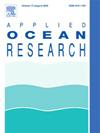仿生机器鱼精确轨迹跟踪的数据驱动动态建模
IF 4.3
2区 工程技术
Q1 ENGINEERING, OCEAN
引用次数: 0
摘要
我们建议利用注意力机制和深度神经网络来开发一个水动力识别模型,并结合时间触发非线性模型预测控制器(ENMPC)来实现机器鱼的精确轨迹跟踪。采用中央模式发生器(CPG)网络设计了机器人鱼的协同步态控制器,使其能够协调胸鳍和柔韧体/尾鳍,实现多模态运动。我们利用计算流体动力学(CFD)模拟数据集推导了机器鱼驱动参数与推力/扭矩之间的非线性映射。将注意机制纳入层流效应,构建基于双向长短期记忆(Bi-LSTM)网络的水动力识别模型。这个识别模型是学习作为其逆操作的控制转换模型的基础。最后,调整事件触发的非线性模型预测约束以考虑外部干扰,从而保证机器鱼跟踪误差的收敛,同时最小化计算成本。本文章由计算机程序翻译,如有差异,请以英文原文为准。

Data-driven dynamic modeling for precise trajectory tracking of a bio-inspired robotic fish
We propose utilizing an attention mechanism and deep neural networks to develop a hydrodynamic identification model, integrated with a time-triggered nonlinear model predictive controller (ENMPC) for precise trajectory tracking of a robotic fish. A central pattern generator (CPG) network was employed to design a synergistic gait controller for the robotic fish that could coordinate its pectoral fins and flexible body/caudal fins to enable multimodal motion. We derived a nonlinear map between the driving parameters and the thrust/torque of the robotic fish using a computational fluid dynamics (CFD) simulation dataset. The attention mechanism was applied to incorporate laminar flow effects and construct a hydrodynamic identification model based on a bidirectional long short-term memory (Bi-LSTM) network. This identification model serves as the foundation for learning a control transformation model that operates as its inverse. Finally, event-triggered nonlinear model predictive constraints were adjusted to account for external disturbances and thereby ensure the convergence of robotic fish tracking errors while minimizing computational costs.
求助全文
通过发布文献求助,成功后即可免费获取论文全文。
去求助
来源期刊

Applied Ocean Research
地学-工程:大洋
CiteScore
8.70
自引率
7.00%
发文量
316
审稿时长
59 days
期刊介绍:
The aim of Applied Ocean Research is to encourage the submission of papers that advance the state of knowledge in a range of topics relevant to ocean engineering.
 求助内容:
求助内容: 应助结果提醒方式:
应助结果提醒方式:


